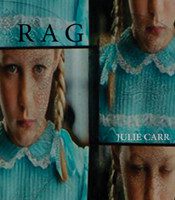In the acknowledgments of Julie Carr’s Rag, her fifth poetry collection, the author once again thanks Lyn Hejinian, and Hejinian offers us as valuable a foothold as any for interpreting Carr’s latest work. Hejinian’s seminal My Life is an extended collage of narrative descriptions—many clearly from childhood, but others less definitively located in time—organized by a schema of compulsively repeated phrases. Revealingly, one of those repeated phrases—“As for we who ‘love to be astonished,’”—becomes about as astonishing as an ant at a picnic over the course of its dozens of appearances. The repetitions, here, degrade language’s associations and acknowledge the flagging conviction of signification. One of Hejinian’s aims in peppering her “autobiography” with these conspicuous repetitions is to indicate that memory is at least as corruptible as the language we have to describe it.
In Carr’s work, repeated lines are deployed more judiciously, but they nod toward a similar interrogation of experience. With Carr, however, the effect of these repetitions is generative, as the allegiances of the speaker and the context of the line shifts radically at each appearance. The phrase “face cannot adjust itself” (18), for instance, occurs the first time immediately following a description of a woman weeping on an airplane:
a woman three rows back, seated between two suited men, suddenly began to sob—loud and unabashed, not bothering to wipe her tears, not covering her face, just sitting staring forward, wailing like a baby. No one said anything. Not the men—one gazed out the window, the other continued to read his screen as if nothing—not the attendants, who did not come.
The “adjustment” apparently called for, here, is the realignment of the woman’s grief to a stoic, unemotional social norm. Later, however, the phrase follows a first-person maternal scene. Still later, a face is a shelter for what seems erotic afterglow: “And now my hope is drunk: a thought in which I do not have a face” (37). Eventually, Carr describes a “fixed face: redolent face” (81), and we are left to wonder, fixed how? Made up? Constructed? Finally, the face becomes an open wound for an unnamed figure, as “her hacked face shines from her fixed face” (84).
Complimenting her concern with fragmented identity, Carr deploys formal fragmentation to rare, successful effect. A handful of double- and triple-spaced poems announce themselves as moments of collection and recollection, successfully punctuating the unified work that might otherwise run together. The lines of these poems are traditionally capitalized, although each line is ambiguously autonomous. For instance:
The majority opinion was against
My “vacation” my “shadow” my “vacation,”
When will I learn to be the author of my own invention?
This from the spider descending the shade (12)
Is this all an imagined monologue from spider/god perspective, or a collection of loosely grouped fragments from multiple ruminations or conversations? I can see it either way, with implications for the supposed singularity of the narrator.
These impulses toward construction and deconstruction, combined with a certain cognitive slipperiness, contribute to Rag’s productively unsettling and kaleidoscopic effect. Carr employs film and filmmaking as an extended trope of poetic discourse from the outset:
It’s always that the lines of color are too stark
So how can I place a hand there, there on the edge of a truck?
One’s body is in response
But today my face grows smaller
I want the narrative of walking to a bus (11)
Panning and zooming through her story, the narrator assumes the role of director. It’s the sort of delusional choice that we make in our own lives, and thus, one to which we can readily connect. As what the narrator/director refers to as “a movie about my life” (54) unfolds, it reveals a range of influences from pornography to home movies to Hollywood talkies. The director and the audience are made complicit in these scenes, even those which are strictly non-filmic, such as the traffic accident intermittently recalled with filmic details. Here, the narrator’s husband and two children witness—and, once home, tearfully describe—a little girl run down by an SUV. They are racked by guilt of their witness, but cannot help bandying back and forth the notion of whether the open-eyed victim was killed or survived. Being director, then, entails less control than one would suppose, and it points to a number of ethical dilemmas involved in the act of envisioning.
 If Carr were to stop at the filmic conceit, she would have plenty enough for a riveting work that reads more like a linked, evolving narrative than a typical collection. However, she seems compelled to make Rag accomplish more than it should, and here, I would have pled for restraint. One of her repeated notions is, “is grieving a politics?” (27). She references “civic lyrics,” “mastering diplomacy” (80), “foundational lust,” and the self as a “conduit for money” (38). These passages feel stilted, less convincing, not because the political fails to inform the personal (it most certainly does), but because this endeavor entails a sort of dual-seeing ascribed to an omniscient presence, well beyond the scope of Rag’s otherwise fallible director. The terminology involved in these passages is also technical, flattening. Here, the collection seems momentarily seduced by heuristics, to the detriment of its compelling human actors. Still, if Carr wishes to address the interaction of the personal and the political, her choice of film is effective, considering the tangle of motivations, patterns of cultural consumption and acting’s simultaneous demands for introspection and exhibitionism. A good director improvises, returns obsessively and anticipates an audience’s reaction on the fly. Carr reminds us that a director, a poet, any creator, has “no true gifts beyond the gift of placing the pieces one / beside another all day and all night” (29). All art is “against the idea of cessation” (103), and the primary imperative is change.
If Carr were to stop at the filmic conceit, she would have plenty enough for a riveting work that reads more like a linked, evolving narrative than a typical collection. However, she seems compelled to make Rag accomplish more than it should, and here, I would have pled for restraint. One of her repeated notions is, “is grieving a politics?” (27). She references “civic lyrics,” “mastering diplomacy” (80), “foundational lust,” and the self as a “conduit for money” (38). These passages feel stilted, less convincing, not because the political fails to inform the personal (it most certainly does), but because this endeavor entails a sort of dual-seeing ascribed to an omniscient presence, well beyond the scope of Rag’s otherwise fallible director. The terminology involved in these passages is also technical, flattening. Here, the collection seems momentarily seduced by heuristics, to the detriment of its compelling human actors. Still, if Carr wishes to address the interaction of the personal and the political, her choice of film is effective, considering the tangle of motivations, patterns of cultural consumption and acting’s simultaneous demands for introspection and exhibitionism. A good director improvises, returns obsessively and anticipates an audience’s reaction on the fly. Carr reminds us that a director, a poet, any creator, has “no true gifts beyond the gift of placing the pieces one / beside another all day and all night” (29). All art is “against the idea of cessation” (103), and the primary imperative is change.
Rag is also concerned with violence, femaleness, sexuality, childhood, parenthood and agency. Carr details the experience of primarily female characters through the lens: “A woman might be a kind of postproduction medium, or a filter through which the desires of the ground are felt” (42). But it may be that Carr’s ultimate concern is a more genderless subjectivity, the constructedness of all those faces. As goes the imagined monologue of one of the actors from the director’s perspective, “consider my identity, she might say” (59). With this statement—hypothetical, projected, filtered—Carr invites her readership to consider the extent of anyone’s agency in a socially proscribed reality. In any case, Rag does admirable work in synthesizing these concerns into a vibrant, continuous series of scenes that are visually, emotionally and aurally arresting. I daresay that Hejinian’s work on subjectivity and identity has found an able and innovative champion in Julie Carr.




